The T-Mobile G2 Preview
by Vivek Gowri on October 7, 2010 12:29 PM ESTOh yes, and now we get to the real stuff. Benchmarks! Let’s start with the CPU benchmarks to see how the 800 MHz 2nd gen Snapdragon matches up with the older 1 GHz parts. All of them implement the same Scorpion architecture, except that the MSM7230 is manufactured on a 45nm process as opposed to 65nm for the QSD8x50. Simple colour coding scheme going on in the graphs here: red for the G2, green for the 1st generation Snapdragon phones, blue for anything running TI OMAP 3 underhood, gold for the Hummingbird Galaxy S devices, black for the iPhone 4, and purple for the Marvell PXA930-running BlackBerry Torch.
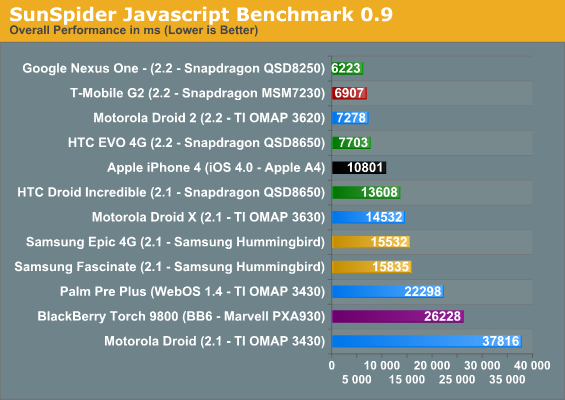
The SunSpider Javascript benchmark is very quick on the G2. While the Froyo Nexus One remains the fastest on most of these benchmarks, the G2 is definitely getting there, probably due to the untouched Android build it’s running. So even with a slower clockspeed, the G2 has a better score on the JS benchmark than the NinjaBlur-equipped Droid 2 and the Sense UI-equipped EVO 4G.

Rightware’s BrowserMark puts the G2 right between the Droid 2, the Fascinate, and the iPhone 4, and about 20% slower than the Nexus One. Given the 20% reduction in clock speed, this is pretty understandable.
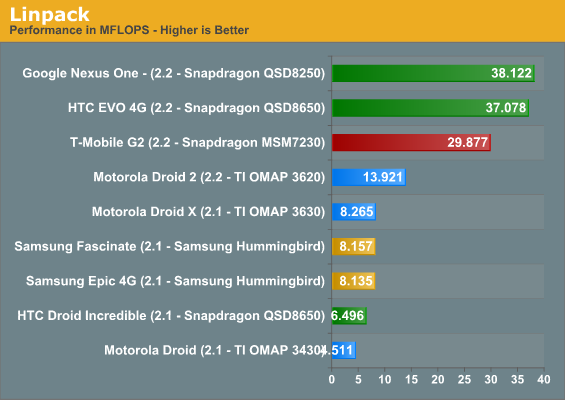
The G2’s Linpack score is about 25% lower than the Nexus One and EVO 4G, but significantly higher than the Droid 2’s score, potentially due to the higher throughput SIMD FP units in Qualcomm's CPU.
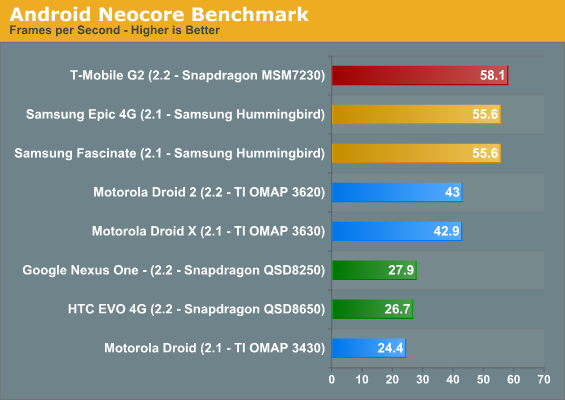
But the really interesting benchmarks are the graphics benchmarks. We’ll start with Neocore, which is Qualcomm’s benchmark to show off the capabilities of the Adreno GPU.
The score is quite good, at more than double the Nexus One’s. The benchmark is capped at roughly 60 fps which is why we see no real difference between the Adreno 205 and the PowerVR SGX 540. For a measurable performance difference we turn to our old favorite: Quake 3.
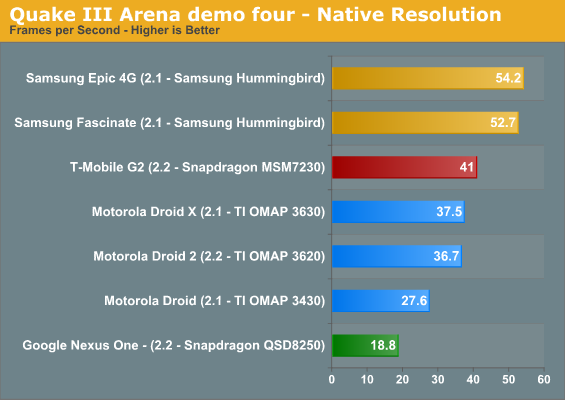
In a neutral gaming benchmark like the Quake III Arena demo, we can really get a feel for how fast Adreno 205 is. And though nothing on the market can touch the SGX 540, the Adreno 205 basically runs rings around the Adreno 200 in the EVO and Nexus One and even outpaces the SGX 530 in the Droid 2 and Droid X. So while the Adreno 205 isn’t world beating, it brings about a huge change by making the the 2nd generation Snapdragon SoC competitive as far as GPU performance goes. Qualcomm no longer comes with a GPU performance tradeoff.
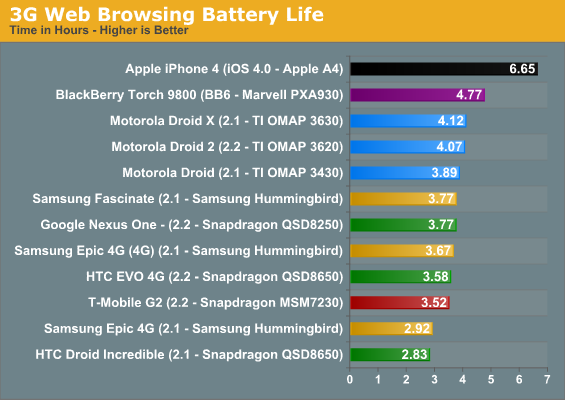
The G2 comes with a pretty small battery, a removable 4.81 Wh (1300 mAh) Li-ion affair that can be easily accessed and replaced. The Nexus One came with a 5.18 Wh battery, the Droid 2 had 5.2 Wh capacity on tap, the Droid X had a 5.6 Wh unit, and the EVO used a 5.5 Wh battery. So naturally, with a lower capacity battery, the G2 comes with less battery runtime too. Thus far we’ve only had the time to run the 3G web browsing battery life test, and the G2 is way down at the very bottom of our charts, matching the Palm Pre Plus in battery life (which has a 1150 mAh battery). It’s not too bad, it’s on par with the Nexus One for minutes-per-Wh efficiency, but 3.5 hours of 3G web browsing is still not very good.
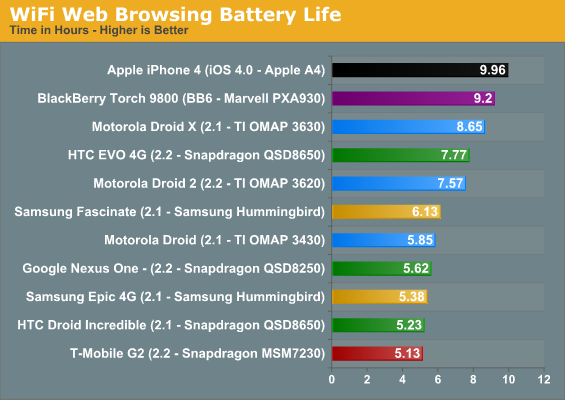
Update: We're adding battery life tests as we go, so here's the WiFi browsing test. Again, it's almost at the bottom, again it's about on par with the Nexus One on an efficiency level. It's a small battery, so when compared to phones that have 10-20% more battery capacity, it does look quite poor. What does seem to be consistent though is that the OMAP 3 phones are more power efficient, even on a per-Wh basis.

But given the 3G speeds the G2 is pulling, maybe we should give it a pass. T-Mobile's HSPA+ network is FAST, even in areas of Seattle that have rather poor signal coverage. On average, I'm pulling around 5.5 Mbps downstream and anywhere between 1 and 1.5 Mbps upstream. Interestingly, this is signifcantly faster than the speeds I saw out of Sprint's WiMAX 4G network on the EVO when I had it in June. While I can't vouch for areas that don't have T-Mobile's HSPA+ network enabled yet, the areas that do should see the G2 fly. It's T-Mobile's first HSPA+ device, so it should be able to utilise the full potential of the faster network.










59 Comments
View All Comments
Trefugl - Thursday, October 7, 2010 - link
He says that the phones should have 4GB but his only has 2GB pretty plainly...I for one don't think that it is just "a pretty simple assembly line mixup"... that's one huge problem if their inventory system and QA guys are so messed up that they let allow more than a few batches of products to leave with half the NAND intended. People's heads would be rolling at every company that I've worked for if that happened! Maybe it would be understandable for Engineering units and prototypes, but not for full scale production.
phoenix79 - Thursday, October 7, 2010 - link
You seem to be missing something... They DO have a 4GB chip in themhttp://forum.xda-developers.com/showthread.php?t=7...
Any google search will pop this up
Trefugl - Friday, October 8, 2010 - link
Thanks for the link. Interesting that it's not showing up in the OS.Would have been nice if you could have given some more detail the first time instead of essentially linking to lmgtfy.com. Seemed like a blunt attack on the article without even giving some direction to those of us readers who don't feel like wasting 5+ mins googling for info on a product that we're not going to purchase (and I would have to do this for every product I see an article on as well...).
clarketelecom - Thursday, October 7, 2010 - link
So, are you just interested in Physics or are you taking the class for engineering, material science etc.? Just wondering because I have a big interest in Physics, mainly theoretical and I'd like to make that interest more practical - is that a good textbook?Thanks.
designerfx - Thursday, October 7, 2010 - link
Anand, I hope you realize that the nexus one does not perform better than the epic on anything.I suggest you run a lagfix and then re-run the benchmarks as not a single phone in the lineup, including the new iphone, will not beat a single samsung phone at that point of the new galaxy lineup.
Likewise, the FPS are capped at 55 (rougly rounded to 56 in benchmarks). It's a known issue, and is the only reason the nexus had a higher benchmark score.
The graphics core on the samsung galaxy phones is actually faster than even the iphone, by a substantial margin.
designerfx - Thursday, October 7, 2010 - link
so either voodoo lagfix or ryanza, anything like that, and it's enough to put the samsung at the top of the charts.zxc367 - Thursday, October 7, 2010 - link
I hope you realize that it's not Anand writing this, its Vivek Gowri. Check the author next time. ;)designerfx - Thursday, October 7, 2010 - link
realized after the fact. why can't we edit our comments? zzz.silverblue - Friday, October 8, 2010 - link
It'd be nice to see all those devices in a head-to-head once they've all got Froyo installed. The Galaxy S phones are really being crippled by 2.1 in these tests.TareX - Thursday, October 7, 2010 - link
It's such a shame this phone has NO 2-WAY VIDEO CALLING in its future. My parents and friends live in a different continent and it would be nice to have the option to get in touch with them anytime, anywhere from a device that fits in my pocket.Also, I disagree with the author about the 3.7" sweetspot. I think the 4" size is the real sweetspot, with 4.3" being too big.